|
SALINAS
"In the Midst of a Loneliness": The Architectural History of the Salinas Missions |

|
CHAPTER 9:
THE RETURN TO THE SALINAS MISSIONS (continued)
ABO: HOUSES AND SHEEP RANCHING (continued)
Photographs of the Ruins
By 1882 Juan José was dead, and his son Ramon was the head of the Sisneros family. His house stood on the east side of the compound near the northeast corner. At the same time, Marcos Luna lived in a house built on the east edge of the convento ruins. Adolph Bandelier stayed in Ramon's house when he visited Abó during Christmas of 1882 and drew a plan of the entire pueblo, mission compound, and most of the settlement. [12]
Bandelier succeeded in taking only one photograph of the ruins of San Gregorio. The picture is almost useless, because the intense cold affected the chemicals of the plate and prevented a clear image. Only vague details can be made out in the print. Enough can be seen, however, to identify the southeast buttress of the church facade still standing to the height of the walls of the nave. There is no clear indication of a tower extending above the wall line, adding support to the appearance of the church as recorded by James Abert in 1846. [13]
Charles Lummis visited the ruins in 1890 and took four photographs. He had better luck with the weather, and two of the four pictures are sharp, clear records of structural details. The other two are slightly out of focus but still of great importance. These pictures preserve evidence of the interior structure of the church that could never have been deduced from the plan of the building, and permit the detailed reconstruction of the roof, balconies, and catwalk described in this report. [14]
 Figure 24. Abó as painted by Abert in 1846. The painting documents a number of critical details about the church and its surroundings. No traces of the front porch are visible, and the lintels of the front entrance and choir loft window are both gone, probably destroyed in the fire that gutted the building in perhaps 1830. The deep notch on the east (right) side marks the location of the window at the mid-point of the nave, while the choir loft doorway does not seem to be visible at all. The second-story doorway that once opened from the roof of the sacristy into the east side-chapel has fallen out above the location of the lintel, but the collapse has not penetrated all the way up to the parapet. On the west (left) side of the nave, the high point marks the location of the buttress outside the wall, while the drop-off to its left probably indicates the location of the notch where the masonry has fallen above the sacristy doorway. Beam sockets can be identified on the north wall of the church. In the original watercolor, differences in shading indicate that Abert could see five sockets in the north wall of the sanctuary, and the first two sockets of the beams over the apse. These two sets of sockets are at about the same height, indicating that the ceiling of the apse was almost as high as the ceiling of the sanctuary. To the right of the church, the walls of the sacristy still stand to about their full height. The ruined wall in the foreground and a poorly-defined wall extending across the background to the right of the sacristy, below the trees, all appear to be ruins of the ca. 1810 to ca. 1830 reoccupation of the area. The interior of the church still clearly shows extensive traces of the white plaster that once covered it. |
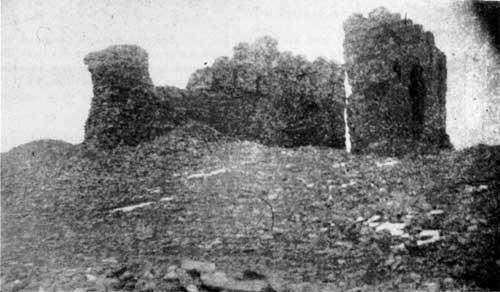 Figure 25. Abó in 1882 as photographed by Bandelier. This picture was taken from almost the same angle as Abert painted his watercolor 36 years before. Since Abert's watercolor, large sections of the walls of the church have fallen. The southwest tower and the south end of the west wall of the nave have fallen, as well as the east wall of the nave from the southeast tower to the east side chapel. The southeast tower itself still stands. At the north end of the church, the entire apse wall of the building has fallen. The crenelations along the tops of the walls can easily be seen. Biblioteca Apostólica Vaticana, Archivo Fotographico, # 482-47, courtesy Charles Lang. |
In 1892, Ramon applied to the United States government for title to the quarter-section in which the ruins of Abó were located. After demonstrating the validity of his claim to the land, he was granted title. [15]
Ramon died about 1900, and his brother (or son) Joaquin became the head of family. [16] Joaquin contracted an agreement to sell water to the Eastern Railway of New Mexico at the Scholle watering point about 1909. [17] In the period from 1880 to about 1910 branches of the Sisneros family, and perhaps some other settlers, built a number of new houses among the ruins of the pueblo. These houses were largely empty and falling to ruin by 1920. [18]
In 1912, the Sisneros family lost title to the portion of the quarter-section containing Abó and in 1915, Ubaldo Sanchez and his wife Beatriz acquired title by tax redemption. They sold the quarter-section to Joe J. Brazil in 1919. Brazil then sold a half interest in the land back to Joaquin Sisneros. The remaining half-interest was sold to Abundio Peralta. [19]
Joaquin died in 1926, and the family divided his estate in 1928. In 1934, Federico Sisneros bought all the family-owned interest in the site of the pueblo and church from the remaining heirs, and all interest in the tract along the north side of the church and convento. [20]
During the years from 1900 to 1930 photographers recorded the collapse of the walls of the church of San Gregorio. These photographs show that the side walls of the sanctuary and north walls of the side chapels fell by about 1900. The west side chapel wall collapsed before 1910, while the east side chapel wall split down the center of the east balcony doorway. The multiple buttresses of the bell tower kept the south wall of the west side chapel standing (until the top five feet of it were intentionally removed in 1972), but the top of the south wall of the east side chapel fell in about 1910, leaving only a small section of the east wall of the side chapel, along the south side of the balcony doorway, still standing. [21]
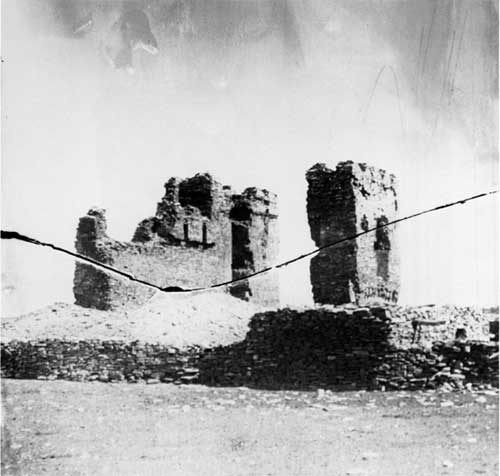 Figure 26. Abó as seen by Charles Lummis in 1890. This picture was made from almost the same angle as the Bandelier photograph 8 years earlier. In the interval the southeast tower had finally collapsed, but few other changes can be seen. In the foreground, walls and structures constructed during the second reoccupation after 1860 are visible. Bandelier's photograph was taken somewhat closer to the church, so that these walls and structures were behind him, out of the picture. Courtesy Southwest Museum, # 24832. |
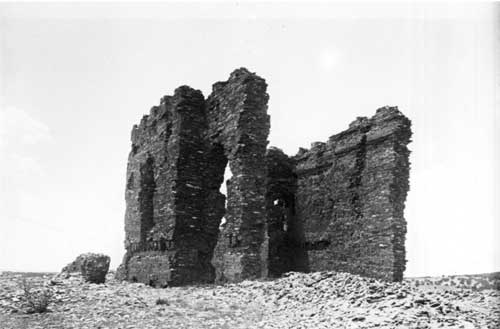 Figure 27. A second view of Abó in 1890. This picture is looking towards the southwest, and the north or sanctuary end of the church is in the foreground. In both this and the previous picture, the crenelations at the top of the building can be seen clearly. These two Lummis photographs are critical to the analysis of the structure of Abó, because only they record several items of important information. The wall at the right in this picture is the west wall of the sanctuary (or transept in the case of Abó, with its peculiar arrangement of space. At the top of the wall, below the crenelations, can be seen two horizontal bands in the stonework. The upper of these is the scar left by the roofing above the roof vigas themselves, which in this area ran lenghtwise down the church, or parallel with this wall. The lower horizontal band marks the sockets of the bond beams creating the box-like structure around the wall tops of the high walls of Abó. The bare wall between the two bands was covered by the westernmost of the roof vigas in this area. The vertical, irregular scar down the face of the wall was produced by a failed roof canal. Instead of draining roof water through the wall, the canal became blocked, the water pooled, the roof seal failed, and water began running down the inner face of the wall, cutting this channel. This indicates that the roof sloped down towards this wall. In this and the previous photograph, three sockets can be seen in the irregular scarring left by the leak. They line up with three sockets a few feet to the south at the corner of the side chapel. The six sockets together are the last traces of the central support for the high roof of the church as well as the catwalk from balcony to balcony. The sockets for the floor of the west balcony are visible below and to the left. On the left, or east, side of the church, the second window into the sanctuary can be seen above the remnants of the sacristy doorway. To the left of the sanctuary window is the large doorway that once opened from the sacristy roof onto the east balcony inside the church. The beam sockets and bond beam sockets for the sacristy roof are visible below this door and the sanctuary window. Courtesy Southwest Museum, # 24831. |
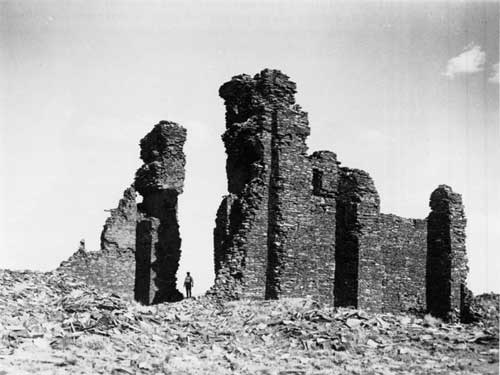 Figure 28. Abó from the northwest in 1916, by Jesse L. Nusbaum. The walls of the sanctuary and side chapels have fallen, except for the buttressed area of the bell tower, and the tower buttress on the east side. The southernmost bottom corner of the balcony doorway is visible just to the right of the figure sitting on the sill of the doorway on the wall. Below the doorway can be seen the irregular traces of the sockets for the eastern balcony. On the shadowed north face of the east tower buttress, the dark patches of the socket for the viga that supported the balcony can be seen, with the sockets of the balcony railing above it. The large depression in the wall above the railing sockets is the socket for the east end of the lower clerestory vigas and corbels; the hole through the wall at this point marks the end of the vigas themselves where they penetrated to within inches of the outer surface of the wall. Several feet above this is the smaller indentation of the upper clerestory viga socket, and in the irregular wall surface above this and below the crenelations are the sockets of the vigas and corbels for the high roof above the clerestory. A similar series of sockets can be seen in the bell tower section of the west wall, closer to the camera. Courtesy Museum of New Mexico, # 12876. |
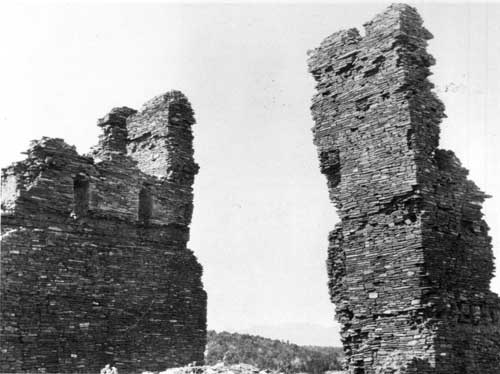 Figure 29. Abó in about 1916. This is a closeup of the southeast corner of the east side chapel and the east face of the west wall of the nave, taken by an unknown photographer. Fine details such as the second level of inset of the crenelations and the imprints of both bond beams on the west wall can be seen. The scar of the east wall of the nave is visible on the east buttress tower, and the corbel sockets, viga sockets, and the scar of the small section of wall that had been at the edge of the doorway from the sacristy to the corridor can all be seen in this view. To the left of the rectangular sockets of the sacristy roof, the smaller round sockets of two corridor roof-beams are visible, and next to them on the south face of the tower, the irregular horizontal shadow line in the stonework marks the upper surface of the roof of room 18. Courtesy Museum of New Mexico, # 58308. |
By the time preservationists began to actively consider the possibility of excavating and stabilizing the church, most of it had fallen. Only an impressive section of the west nave wall and the bell tower stood to the height of the original wall top. This small piece of the original building, however, was enough to indicate the size and impressiveness of the whole.
| <<< Previous | <<< Contents >>> | Next >>> |
sapu/hsr/hsr9a.htm
Last Updated: 28-Aug-2006